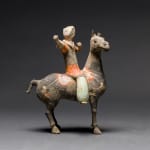Han Polychrome Horse and Polo Player, 206 BCE - 220 CE
Painted Terracotta
height 34.3 cm
height 13 1/2 in
height 13 1/2 in
RD.048
Further images
The great influence of the horse throughout the history of China cannot be underestimated. It is no debate that the ancient expansion of the Chinese Empire was due in large...
The great influence of the horse throughout the history of China cannot be underestimated. It is no debate that the ancient expansion of the Chinese Empire was due in large part to the introduction of the animal into Chinese civilization. Their rapid mobility allowed for quick communication between faraway provinces, facilitated trade and transportation, and furthered military conquests of distant lands with their stamina, strength and stature. The importance of the horse in the history and culture of China can be viewed, in part, through the artistic legacy of this great civilization. In sculpture, painting, and literature, horses were glorified and revered, and as such, the prevalence of the horse in Chinese history has turned it into somewhat of a symbol for China itself, especially in art historical contexts.
During the unification of China under the Han Dynasty, bands of mounted nomadic warriors from the north threatened the country. To thwart their attacks, the Chinese sought to import stronger, faster steeds from Central Asia (as opposed to the Mongol ponies used by the invaders), eventually leading to the creation of the Silk Road. Such steeds were also employed for more novel reasons, however, particularly for use in the sport of Jiju, or polo.
Jiju, also called “ball hitting,” is the early form of polo. While it is believed to have been introduced, or even created in Han China, it achieved tremendous popularity during the later Tang dynasty. The sport’s popularity continued well beyond the Tang, however, finding followers through the Liao, Jin, Yuan, and Ming Dynasties, especially within the circles of the imperial court and military troops. The sport was mainly aimed at training cavalrymen in the Tang Dynasty, but in other dynasties, the Han included, it was treated more as a sporting event quite similar to modern-day polo.
This small sculpture of a mounted polo player is a testament to the importance of the game – and the horses that made the game possible – in Han China. Targeted towards the wealthy elite and the military men, both the horse and the rider exhibit stunningly colorful and elaborate attire. The magnificent regalia of the horse, including detailed headgear and a brilliantly painted saddle in red and gold/green, reflects the respect this animal received as an animal that provided security and strength to the expanding empire. And naturally, the player himself is gorgeously decorated with a painted red and grey tunic and a unique headband. He would have originally held a wooden mallet in between his hands that have now rotted away with the ravages of time.
This remarkable sculpture is a creation of immense cultural and historical significance that attests to the critical role of polo and the horse in ancient Chinese civilization.
During the unification of China under the Han Dynasty, bands of mounted nomadic warriors from the north threatened the country. To thwart their attacks, the Chinese sought to import stronger, faster steeds from Central Asia (as opposed to the Mongol ponies used by the invaders), eventually leading to the creation of the Silk Road. Such steeds were also employed for more novel reasons, however, particularly for use in the sport of Jiju, or polo.
Jiju, also called “ball hitting,” is the early form of polo. While it is believed to have been introduced, or even created in Han China, it achieved tremendous popularity during the later Tang dynasty. The sport’s popularity continued well beyond the Tang, however, finding followers through the Liao, Jin, Yuan, and Ming Dynasties, especially within the circles of the imperial court and military troops. The sport was mainly aimed at training cavalrymen in the Tang Dynasty, but in other dynasties, the Han included, it was treated more as a sporting event quite similar to modern-day polo.
This small sculpture of a mounted polo player is a testament to the importance of the game – and the horses that made the game possible – in Han China. Targeted towards the wealthy elite and the military men, both the horse and the rider exhibit stunningly colorful and elaborate attire. The magnificent regalia of the horse, including detailed headgear and a brilliantly painted saddle in red and gold/green, reflects the respect this animal received as an animal that provided security and strength to the expanding empire. And naturally, the player himself is gorgeously decorated with a painted red and grey tunic and a unique headband. He would have originally held a wooden mallet in between his hands that have now rotted away with the ravages of time.
This remarkable sculpture is a creation of immense cultural and historical significance that attests to the critical role of polo and the horse in ancient Chinese civilization.







